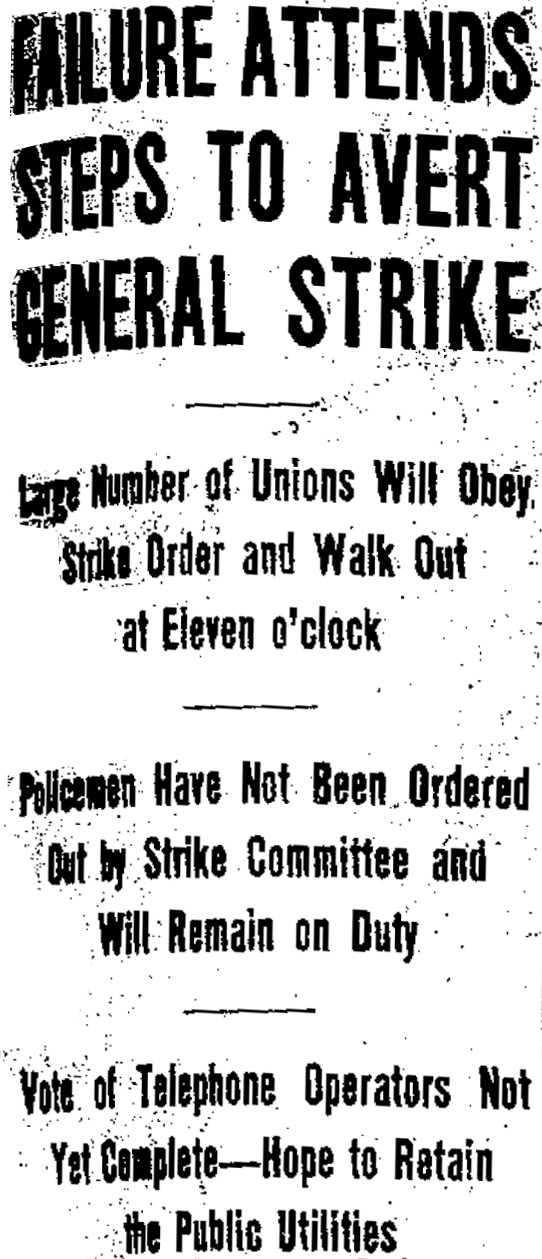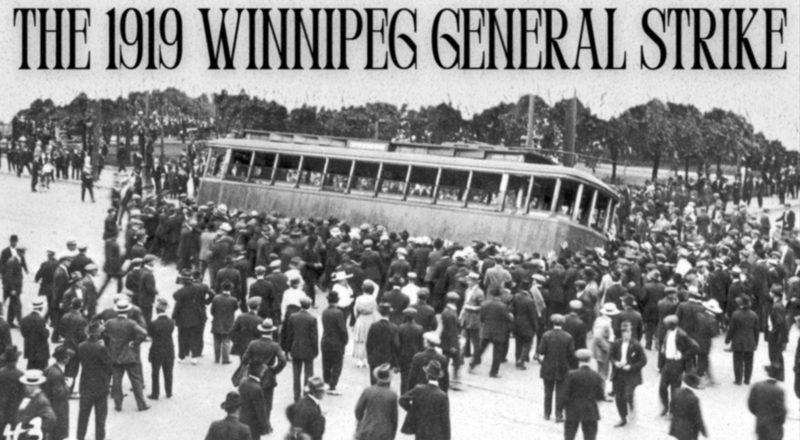
/ Blog
May 15, 2019
The 1919 Winnipeg General Strike: The Strike Shuts Down Winnipeg
As 2019 marks the 100th anniversary of the 1919 Winnipeg General Strike, Heritage Winnipeg is commemorating the year by looking back at the events during this tumultuous period of history that helped shape our city. This article is part of a series of guest posts reflecting on the some of the places that bore witness to the Strike and the events leading up to it. Read all the blogs in this series from the beginning:
Walker Theatre Meeting Sets the Stage
Population Growth and the Canadian Pacific Railway Station
The Western Labour Conference in Calgary
Breaking Point – Contract Negotiations Stall
The Strike Shuts Down Winnipeg
Veterans Protest With and Against the Strike
Specials and Strikers Riot
Raids and Arrests
Bloody Saturday
Russell Sedition Trial
The Winnipeg Trades and Labour Council (WTLC) took a vote on whether or not to support the two union Councils and the two strikes that started on May 1st and 2nd. The WTLC represented a range of affiliated unions from different sectors in the city – manufacturing, sewing trades, city workers, transport workers. A vote of the 94 member unions was taken on May 6th – 8,667 voted for a general strike, while 645 vote against.

Source: Manitoba Free Press, May 15, 1919, page 1 (pubic domain)
Within a week, about 12,000 unionized workers joined in a general strike. They supported the demand for a living wage and recognition of collective bargaining as a principle for labour relations with employers. They knew that supporting the striking workers would affect the bargaining power of all unions, and therefore there was a common interest in demonstrating union solidarity.

Source: Winnipeg Tribune, May 15, 1919 (public domain)
The WTLC put out a call to start the general strike at 11:00am on May 15. However, for about 500 telephone operators who were coming to work at 7:00am that day, a shift change was an opportunity to stop work and join the Strike. Within hours, the city was in turmoil as many services were stopped or reduced, businesses shut down and industries were forced to operate with a few management staff or replacement workers. Carpenters, electricians and other employees of the City of Winnipeg did not come to work. Postal workers, government employees and domestic workers joined the Strike. The streetcars stopped running, garbage collection was suspended, restaurants were abandoned by their employees, even elevators stopped running in certain buildings in downtown Winnipeg. When the pressmen walked off the job, major newspapers stopped printing for a week. Over the next few days the police, pressmen and firemen voted to join the general strike. Suddenly, it was difficult to find a barber, to send a telegram or to travel across the city. At the beginning of the Strike there was also no ice, milk, bread, and very little meat being delivered. The city virtually stopped operating.
When the workers across the city started to leave their workplaces, another estimated 12,000 non-unionized workers joined the Strike in ‘sympathy’. Many of these workers were recent immigrants who were invited to Canada but found living conditions very difficult. Basically they turned the Strike into a huge social protest. In a city with about 180,000 residents at the time, a conservative estimate is that a third of the population, workers and their families, were on strike.
The Western Labor News, Strike Bulletin on May 27th captured the energy exhibited by the strikers:
Are we downhearted? No. This is the tone of the thirty-five thousand workers on strike in this city today. Every kind of attempt has been made to get the workers back on the job, from Government ultimatums to petty bribes on the part of individual employers. But in spite of all, the thousands stick and every local stands as solid as adamant. There is no give. Every striker says it is a fight to a finish and we will finish it.
THANK YOU TO THE SPONSOR OF THIS BLOG POST:

Guest post written by Dennis Lewycky.
Edited by Heritage Winnipeg.











